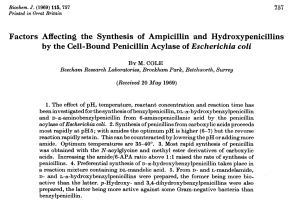https://youtu.be/WQE2nCaihNQ
https://www.google.com/patents/US7951403
The Structure of Amoxycillin Trihydrate and a Comparison with the Structures of
Ampicillin Bole et al 1978The structure of amoxycillin trihydrate with formula C 16H19N305S. 3H20 has been determined.
It crystallizes in the orthorhombic system with space group P212~21 and four molecules in a unit cell of
dimensions a = 15.622 (17), b = 18.785 (14) and c = 6.645 (9) /~,. The structure was solved by multisolution
tangent formula refinement from intensity measurements obtained by microdensitometer from equiinclination
Weissenberg films. Least-squares refinement yielded an R value of 0.061 for observed data. The
molecular configuration is almost identical to that of ampicillin trihydrate and the crystal packings of these
two compounds are very similar with the addition in amoxycillin of H bonding between the aromatic OH and
O(12) of a symmetry-related molecule. The structures of amoxycillin and ampicillin are compared in detail
and the inability of amoxycillin to crystallize in forms similar to ampicillin anhydrate and delta-form
ampicillin is discussed.
href=”http://journals.iucr.org/b/issues/1978/02/00/a15796/a15796.pdf”
Analysis of moisture content is critical to ensuring material quality
Moisture content analysis is a critical component of material quality and essentially a function of quality control in most production and laboratory facilities. From biological research organisations, pharmaceutical manufacturers, to food producers and packers, moisture content control greatly influences the physical properties and product quality of nearly all substances and materials at all stages of processing and final product existence.
EverGreening: An Abuse of the Patent System – Academike
“Editor’s Note: Intellectual Property laws are one of the most complexed laws that exist today. India, in order to strengthen its patent regime and align it with the TRIPs agreement, introduced amendments to the Patent Act in 2005, with a special focus on the pharmaceutical industry.
Ever-greening in Pharmaceuticals: Strategies, Consequences and Provisions for Prevention in USA, EU, India and Other Countries
Arun Kumar* and Arun Nanda Department of Pharmaceutical Sciences, Maharshi Dayanand University, Rohtak, India *Corresponding Author: Arun Kumar Department of Pharmaceutical Sciences Maharshi Dayanand University, Rohtak, India Tel: +01262 393 596 E-mail:[email protected] Received Date: September 16, 2016; Accepted Date: April 07, 2017; Published Date: April 18, 2017 Citation: Kumar A, Nanda A (2017) Ever-greening in Pharmaceuticals: Strategies, Consequences and Provisions for Prevention in USA, EU, India and Other Countries.
Is Patent “Evergreening” Restricting Access to Medicine/Device Combination Products?
Not all new drug products are truly new. Some are the result of marginal innovation and incremental patenting of existing products, but in such a way that confers no major therapeutic improvement. This phenomenon, pejoratively known as “evergreening”, can allow manufacturers to preserve market exclusivity, but without significantly bettering the standard of care.
MOISTURE CONTENT: A STABILITY PROBLEM IN PHARMACEUTICAL PRODUCTS
The term moisture, usually defined as wetness conferred by an unidentified liquid1, is assumed here to be due to water. Thus the scope of this article is the characterization of and consequences due to relatively small amounts of water associated with solids of pharmaceutical interest.
water content in pharmaceutical products – Google Search
Difference between moisture content or water content test and loss on drying test … LOD or total moisture content of Pharmaceutical products can include both …
